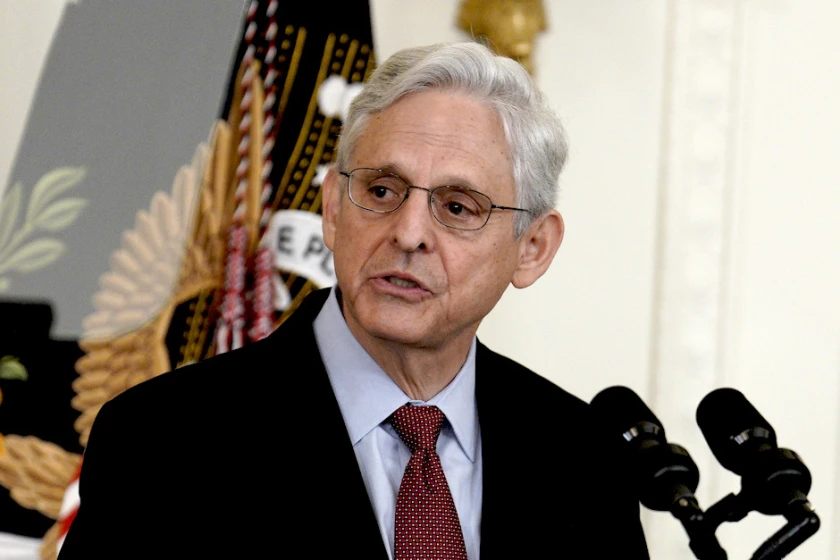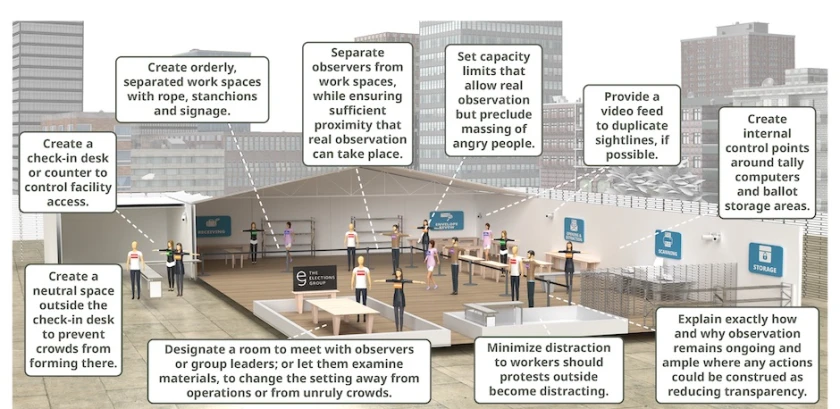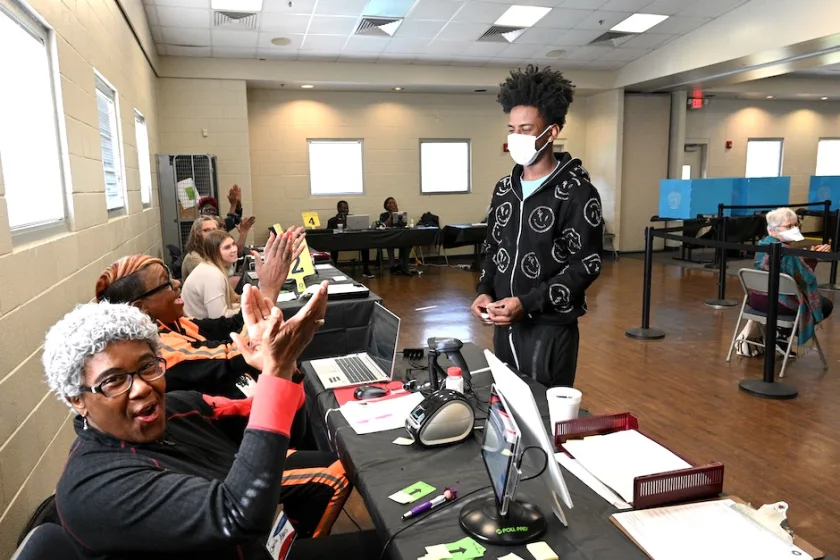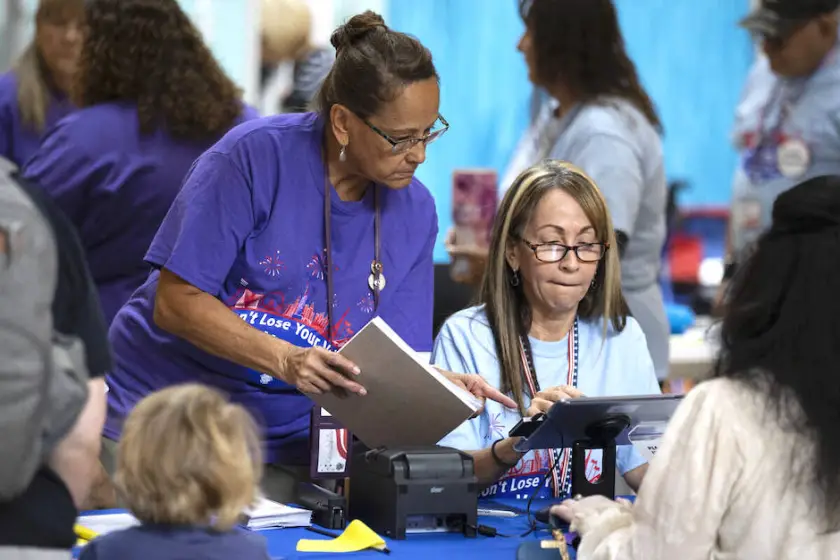Early voting for midterm elections is well underway in many states, and so far has proceeded without major incident. But a new Reuters/Ipos poll finds that four in 10 of American voters are worried they will encounter intimidation or threats of violence at polling places. (Two out of three fear actual violence from extremists if they are displeased with election outcomes.)
In a paradoxical crusade for transparency, armed “observers” stationed themselves near Arizona ballot boxes with their faces and license plates masked, taking photos of voters and their vehicle tags. A group of retired and Latino voters filed a lawsuit against the organization the watchers claim to represent.
Responding to news of such activity, U.S. Attorney General Merrick Garland has said that the Justice Department “will not permit voters to be intimidated” during midterms. Last year, the DOJ established a task force to address threats against those involved in administering elections and an 800 number and online complaint form for reporting threats to the FBI.
The prospects for disruption vary within the more than 170,000 electoral precincts in the country, but physical and cybersecurity are priorities for all. Moreover, vigilantes can create uncertainty by menacing officials across state and local borders.
🧵On Friday, 2 armed individuals dressed in tactical gear were onsite at our Mesa ballot drop box. After @mcsoaz arrived, the individuals left. @MaricopaCounty Chairman Gates & @RecordersOffice Recorder Richer said they condemn these actions. Read more: https://t.co/iHFPCxeLFT pic.twitter.com/o8JCudzVCj
— Maricopa County Elections Department (@MaricopaVote) October 23, 2022
In seven years serving as city clerk for Rochester Hills, Mich., Tina Barton hadn’t faced a threat to her security. But in November 2020, she received a death threat. After analyzing a recording with an FBI election crime coordinator and her husband (a law enforcement officer), she came to believe the call came from outside the local area.
“You don’t think you’re going to be a target, but you cannot discount the possibility that someone in another part of the country will want to strike out against you,” she says. “To not consider yourself vulnerable to some degree would be a misunderstanding of where we’re at in our society.”
Barton is currently senior election expert for The Elections Group and a member of the Committee for Safe and Secure Elections (CSSE). Both organizations were created by former election officials to provide support to that community, and both have developed no-cost resources that specifically address election security.
Even though the midterms are less than two weeks away, there are measures that can still be taken to make polling places more secure, Barton says, and they have relevance even if thorough plans are already in place. “Election officials are always considering how they can get better and do better.”

U.S. Attorney General Merrick Garland. In 2021, the Department of Justice created a task force to address threats against those involved in administering elections. (Yuri Gripas/TNS)
Naming the Players
The CSSE has highlighted five steps to safer elections, which involve collaboration between election officials and law enforcement. They begin with meetings and conversations about how each would respond to specific types of threats, voter intimidation or violence.
“It’s important to have those relationships ahead of time, so that when something happens and you call, it’s not the first time they’re hearing from you,” says Harold Love, a CSSE member who served 25 years with the Michigan State Police.
With less than two weeks to the election it may be asking a lot for stakeholders to find time to reach out, says Barton. “But if all that people have is one hour, that hour may make all the difference.”
An election emergency might require assistance from communications staff or EMS providers as well as law enforcement. All need to understand their roles and share their respective institutional knowledge, Barton emphasizes.
“You talk through scenarios that might possibly happen, and who is going to respond first — which complaints go to the local election official, and which are escalated directly to law enforcement?” This can reduce chaos and confusion on Election Day and lead to better outcomes.
“In my field, when you fail to plan for contingencies that’s when those things tend to happen,” says Justin Smith, the sheriff of Larimer County, Colo., another CSSE member. “You don’t want to be in a tense situation visiting a topic for the first time.”
Barton sees drop boxes as an immediate priority for this process. They have become hot spots already due to unsupported conspiracy-fueled fears that “mules” will carry illegitimate ballots to them. One group holding a “drop box tailgate party” in Arizona bragged on social media that it had scared off one such mule — in reality, a voter hoping to post an early ballot — “just by being there.”

A range of groups cohesed around election denial have recruited citizen “observers” to monitor election processes, and unprecedented crowds are possible. This diagram shows elements of an obstruction-free facility for counting ballots. (The Elections Group)
Crowd Management
Crowds are another looming concern. Election deniers from Steve Bannon, “Stop the Steal” and other special interest groups to Republican party organizations have made efforts to recruit and train armies of poll watchers.
“We’re going to see a crowd management issue that I don’t think we’ve ever really had to deal with in past elections,” says Barton.
One big worry is that onlookers eager to find evidence to support their suspicions of malfeasance could seriously interfere with the activities of voting, ballot handling and tabulation. Room capacity limits, control points for entrances and exits, and spatial organization have new importance.
Ballot counting is a major concern, and The Elections Group has developed resources to aid facility preparation. The need for this work to be free of obstruction and disruption is compounded by the potential for a repeat of turmoil unleashed in 2020 by viral reports and videos of “fraud” from observers who did not understand what they were seeing.
Whether caused by agitated crowds or individual aggression, it’s possible that tensions at polling places or counting facilities will approach dangerous levels. “When you have hundreds of millions of voters, there are going to be some issues here and there,” says Smith.
Election officials, who may have other civic duties — Barton handled liquor licensing, the city council, birth and death records and oversaw three cemeteries as city clerk — must now also be expert in de-escalation, she says. Her group has developed pocket guides and posters that offer guidance to election officials and election workers who find themselves in tense situations.
Other government entities can alleviate the overall stress level by allowing their employees to assist election offices. This relieves pressure to recruit, the need to run background checks or concerns that outsiders with bad intentions might get access to government computer systems. “Resource sharing is incredibly important,” says Barton.
Human Trauma
In addition to his decades of experience in law enforcement, Howard Love is a licensed counselor. He thinks it’s important to remember that the current climate is affecting security in ways that encompass more than processes and polling places.
The community of election officials is in the line of fire, he points out. The threats they are receiving include personal information — where their kids go to school, what kind of car they drive, what time they go to work.
“Imagine the traumatic experience that might be for someone,” he says. “As a result of that trauma, people develop anxiety and depression and hypervigilance that can disrupt their overall wellness and enjoyment of life.”
It’s important for election officials who are subjected to threats to understand that these kinds of reactions are normal, that they are not “losing their minds,” Love says. At the same time, they need to pay attention if they have a sense that someone is following them, or see strange cars in unexpected places, and call the police if needed.
In recent years, there have been reports of instances where law enforcement wasn’t taking such complaints as seriously as it should. The CSSE has helped to change that to some extent by bringing the law enforcement and election communities together, even creating state reference guides containing provisions of election law that delineate criminal violations in the context of elections.
The impact of threats on election workers who are committed to holding the line (and upholding the Constitution) on Nov. 8 is much greater than most people realize, Love says. “We can never do enough, we can never say enough about this. We need to continue to encourage more people to seek help, to talk to somebody, to seek direction on how to deal with whatever they are being subjected to.”

An 18-year-old voting for the first time is cheered by poll workers an early voting location in Georgia. (Hyosub Shin/ AJC/TNS)
The Sliver of a Silver Lining?
The furor about elections emanating from some quarters may have caused waste, distraction and destruction, but it has also brought curiosity about the process of elections to new levels. “I hear more people having conversations about them, and we have a lot of interest at the high school and college levels,” says Barton. “I find it incredibly exciting that they want to know about the process, are interested in getting involved in it.”
Young people who stepped in to take the place of vulnerable seniors when the 2020 election proceeded during a pandemic seem to still be engaged, she says, hoping this might inspire some to choose election administration as a career.
There are learning opportunities as well. The midterms may provide considerable insight into the level of funding necessary to treat elections as “critical infrastructure.” This foundation of American democracy has become vulnerable in unprecedented ways — what might it take in terms of personnel, facilities, technology and law enforcement resources to keep the 2024 election on the rails?
Whatever happens on Nov. 8, Sheriff Smith expects the presidential election to be a much bigger challenge. “It’s a good year to practice and a good year to see how well we’ve educated the public on some of these unknowns.”
“Things are different now,” says Love. “We have to be more diligent so that we can not only protect the workers, but also protect the voters, our systems of voting and the democratic process.”
Republished with permission from Governing.com, by Carl Smith

Governing
Governing: The Future of States and Localities takes on the question of what state and local government looks like in a world of rapidly advancing technology. Governing is a resource for elected and appointed officials and other public leaders who are looking for smart insights and a forum to better understand and manage through this era of change.

